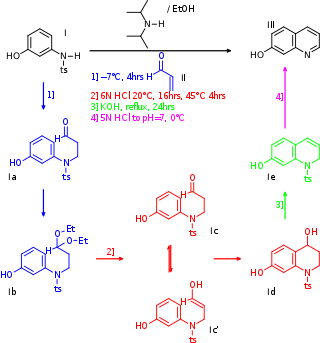Loading AI tools
From Wikipedia, the free encyclopedia
In chemistry a one-pot synthesis is a strategy to improve the efficiency of a chemical reaction in which a reactant is subjected to successive chemical reactions in just one reactor. This is much desired by chemists because avoiding a lengthy separation process and purification of the intermediate chemical compounds can save time and resources while increasing chemical yield.

An example of a one-pot synthesis is the total synthesis of tropinone or the Gassman indole synthesis. Sequential one-pot syntheses can be used to generate even complex targets with multiple stereocentres, such as oseltamivir,[1] which may significantly shorten the number of steps required overall and have important commercial implications.
A sequential one-pot synthesis with reagents added to a reactor one at a time and without work-up is also called a telescoping synthesis.
In one such procedure[2] the reaction of 3-N-tosylaminophenol I with acrolein II affords a hydroxyl substituted quinoline III through 4 sequential steps without workup of the intermediate products (see image). The addition of acrolein (blue) is a Michael reaction catalyzed by N,N-diisopropylamine, the presence of ethanol converts the aldehyde group to an acetal but this process is reversed when hydrochloric acid is introduced (red). The enolate reacts as an electrophile in a Friedel-Crafts reaction with ring-closure. The alcohol group is eliminated in presence of potassium hydroxide (green) and when in the final step the reaction medium is neutralized to pH 7 (magenta) the tosyl group is eliminated as well.
Seamless Wikipedia browsing. On steroids.
Every time you click a link to Wikipedia, Wiktionary or Wikiquote in your browser's search results, it will show the modern Wikiwand interface.
Wikiwand extension is a five stars, simple, with minimum permission required to keep your browsing private, safe and transparent.